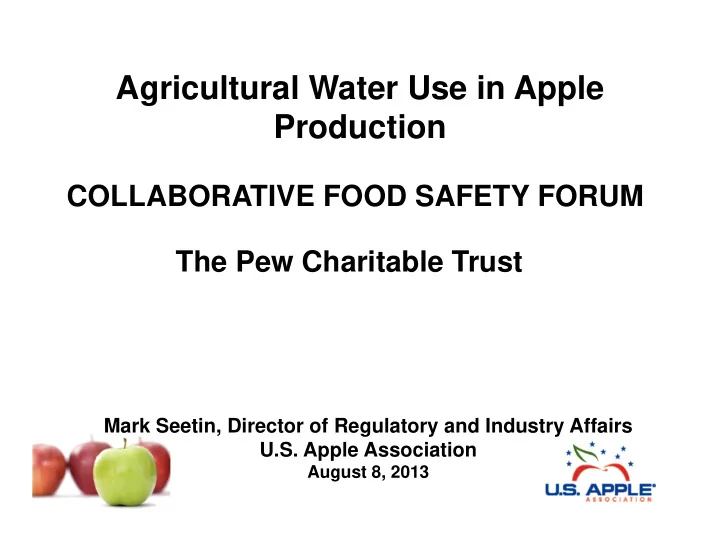

Agricultural Water Use in Apple Production COLLABORATIVE FOOD SAFETY FORUM The Pew Charitable Trust Mark Seetin, Director of Regulatory and Industry Affairs U.S. Apple Association August 8, 2013
Apples are Grown Commercially in 29 States Washington State produces about 60 percent of the apples in the United States. Other leading states include New York, Michigan, Pennsylvania, California and Virginia
Agricultural Water Use in Apple Production Water use is season long for: Irrigation (3 to 3 ½ acre feet in West-1 mil. Gal/ac) Cooling (West) Crop protection chemical spraying (East and West) Significant differences exist in water use in the Western and Eastern production areas
Western apple production - arid environment
Water used for overhead irrigation and cooling
Western orchard irrigation
Typical water sources in the West– canals, ditches rivers/streams – some deep wells
Chiefly via trickle irrigation or micro sprinklers Eastern – Trickle irrigation Water source – wells, ponds and streams
East and West - Orchards are sprayed at regular intervals throughout the season (12-14 applications) Crop Protection – Air Blast Sprayer
West ‐ Overhead sprinkling (cooling) is necessary to prevent sunburn
Chlorine in Water Can Damage Apples
Research on Microbial Survival Research conducted at Washington State University and published in the Internet Journal of Food Safety demonstrated that even when high concentrations of E. coli treated to be environmentally resistant were applied to apples, populations were reduced to minimal levels on apples collected just 1 day after spraying. Sun-Young Lee and Dong-Hyun Kang. Longevity Studies of Escherichia coli on Apples from Tree. Internet Journal of Food Safety, Vol. 5, 2005, p 35-440. http://www.internetjfs.org/articles/ijfsv5-6.pdf Water sources of significantly different water quality (groundwater and ponds) were used to prepare and apply pesticides to tomatoes. Twenty-four hours after the pesticide application treatments, tomatoes were harvested, rinsed, and massaged to elute surface bacteria. The resulting washwater was tested with conventional microbiological and molecular methods. Even after performing the non-recommended practice of applying water with high levels of fecal indicator organisms, there were no significant differences in the microbial load on the tomatoes.” Telias, A, J.R White, D.M. Pahl, A.R. Ottesen, C.S. Walsh. 2011. Bacterial community diversity and variation in spray water sources and the tomato fruit surface. BMC Microbiology 11: 81. Pahl, D.M., A. Telias, M. Newell, A.R. Ottesen, C.S. Walsh. 2013. Comparing source of agricultural contact water and the presence of fecal indicator organisms on the surface of ‘Juliet’ grape tomatoes. Journal of Food Protection. In press Donna M. Pahl comments http://www.regulations.gov/#!documentDetail;D=FDA-2011-N-0921-0145
Agricultural Water Concerns Surface water testing requirements (every 7 days) – expensive over a growing season of 7 months. Apple harvest is at the end, so apples contacted by ag water are not consumed throughout the season. A test exceeding the microbial standard means halting water use – even when the need is great for cooling (prevent sunburn) , for irrigation, or for disease or insect attack. Chlorine treated water could damage fruit and could interact with crop protection chemicals and reduce efficacy. The large volume of water used for irrigation (3-3 ½ acre feet per season) raises concerns over effects of chlorine on soil and soil biology both short and long term.
Agricultural Water Concerns Our concern is that the standard as proposed to apply to apples places an extensive and expensive regulatory framework in place while lacking adequate scientific support or evidence of food borne illness outbreak. It poses substantial issues of liability, undue expense, and the potential for negative impacts on the fruit and the soil without apparent improvement in food safety. We recognize that these issues are complicated and we appreciate FDA’s efforts to better understand them – and we look forward to working with the agency to come up with a workable solution.
Agricultural Water Use in Apple Production Thank You! Mark Seetin, Director of Regulatory and Industry Affairs U.S. Apple Association mseetin@usapple.org
Appendix – Per Capita Consumption Fresh Apples and Processed Products Table 2: Per-Capita Utilization of Apples and Apple Products (Pounds, Fresh Weight Equivalent) Season Fresh Canned Juice Frozen Dried Other Total 2001-02 15.61 4.57 21.29 0.90 0.83 0.25 43.44 2002-03 16.00 4.01 21.45 0.74 0.80 0.17 43.18 2003-04 16.91 4.50 23.13 0.96 0.64 0.36 46.49 2004-05 18.79 4.53 25.28 0.65 0.70 0.45 50.41 2005-06 16.66 4.19 22.26 0.90 0.73 0.54 45.27 2006/07 17.73 4.21 26.37 0.87 0.97 0.60 50.74 2007/08 16.39 3.96 27.14 0.85 0.90 0.52 49.77 2008/09 15.90 4.61 25.05 0.75 0.88 0.78 47.96 2009/10 16.25 4.18 24.92 0.73 0.61 0.63 47.32 2010/11 15.32 3.96 26.36 0.67 0.65 0.66 47.62 2011/12 15.42 4.22 20.84 0.80 0.50 0.67 42.45 2012/13F 15.88 3.57 23.04 0.68 0.61 0.52 44.30 Source: USDA, Economic Research Service, Crops Branch. Per-capita numbers approximate the trend and general level of consumption over time. Annual consumption estimates do not reflect changes in stocks (except for frozen). Therefore, the numbers do not reflect actual year-to-year changes in consumption. Per capita figures are adjusted for imports and exports, and include shipments to territories. F = USDA preliminary forecast. Other includes vinegar, wine, slices for pie making and fresh slices.
Recommend
More recommend